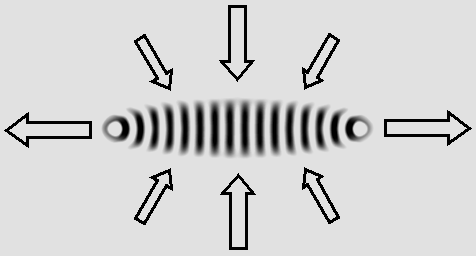|
|
One-way waves around an electron and a proton, responsible for magnetic fields.
|
Why wave mechanics ? Scientists usually speak about quantum mechanics because matter behaves according to Max Planck's constant. This constant is very useful indeed, but it appears to be not so important. Above all, matter behaves according to wave properties, and so its mechanics is nothing else but wave mechanics. Matter is made of waves. We know since Louis de Broglie that matter particles behave as waves. Indisputably, matter is emulating waves, and those waves should be spherical standing waves. Let's make it perfectly clear : there is no alternative. At this stage, it is not an assumption, it is a certainty. On the other hand, an electron isn't a metal marble covered in chrome. An electron cannot be made of matter. It is rather matter that is made of electrons. So, when two electrons are put together, the result must be as follows : |
|
|
|
Note the concentric ellipsoids and hyperboloids.
|
|
Distance 10 l
Waves add themselves between the electrons, but destroy themselves beyond.
|
|
Distance 10.5 l
Waves destroy themselves between the electrons, but add themselves beyond.
UNIFYING ALL FORCES
|
Matter is purely made out of electrons which are standing wave systems constantly radiating spherical waves all around. All forces are transmitted by those waves, and the result is motion as a result of the radiation pressure. The radiation pressure. We know since John Poynting that light exerts a variable radiation pressure. In fact any wave propagating through the aether can more or less "push" matter. It must be understood that any attraction effect actually occurs as a result of a pressure from the opposite side exerted by waves propagating through aether. This is the shade effect. The shade effect. All electrons and positrons in the sun collects their energy from aether waves. So these waves contain less energy while going away from the sun. Waves propagated toward the Earth in the opposite direction are more powerful, and so they will push the Earth toward the Sun. This is the shade effect. However, all electrons and positrons in the Sun will also send waves toward the Earth, and the result (except for gravity, which is a different effect), will be null. The following graphic shows that a gluonic field, which is made of non spherical standing waves, radiates most of its energy on the axis. This is why the gluons' shade effect is particularly intense. The gluonic field will attract any particle around, positive or negative, except on the axis : |

A gluonic field.
|
The lens effect. Standard waves can flow into each other without interference, but standing waves do interfere. Although it is not a well known fact, the lens effect really works. This can be easily tested inside water, for example. Any uncompressible medium will transmit waves faster while the pressure is higher. Because standing waves alternately compress then dilate the aether substance inside antinodes, the regular wave speed is not the same there; this explains the electrons' amplification process. Wave gears : pure mechanics. Matter particles work using "wave gears". One can easily understand that minutes and hours inside a pendulum clock must be converted by gears and that there must be a 60 teeth ratio or any multiple, for instance, 120 : 7200. The point is that all teeth must be similar but that gears may contain more or less teeth. Matter behaves like this analogy. Because the wavelength of an electron is always the same, there cannot be any teeth differences inside matter, and this explains Planck's constant, hence quanta. Active and reactive masses and forces. Lorentz discovered that mass increases according to the gamma factor. This mass increase can be easily calculated using active and reactive masses undergoing the Doppler effect. The same calculus also indicates how forces will act for fast moving systems, showing that Newton's laws are no longer valid. Kinetic energy. The gain in mass, which is worth: g m – m, is responsible for kinetic energy. This means that the kinetic energy of a 1 kg object traveling at .866 c equals its own mass while it is at rest, and that it must be evaluated according to Einstein's: E = m c 2 Because this can be explained by the Doppler effect, this is another evidence that matter is made of waves. |
| 01 | 02 | 03 | 04 | 05 | 06 | 07 | 08 | 09 | 10 | 11 | 12 | You are here. | 14 | 15 | 16 |
| 17 | 18 | 19 | 20 | 21 | 22 | 23 | 24 | 25 | 26 | 27 | 28 | 29 | 30 | 31 | 32 | 33 |
|
Gabriel LaFreniere, Bois-des-Filion in Québec. absolu2000@hotmail.com On the Internet since September 2002. Last update September 26, 2007. |